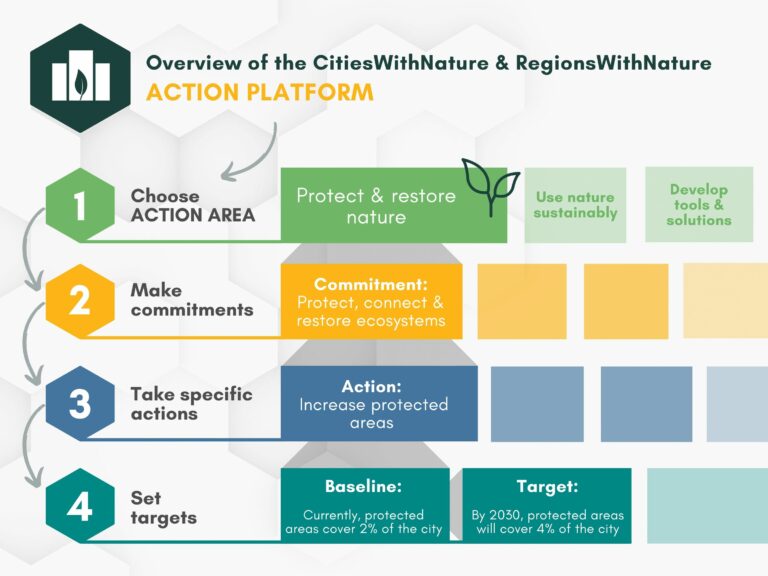What is the Action Platform?
The CitiesWithNature Action Platform accelerates bold action for nature by enabling cities to make commitments and share their achievements. Here cities can show what actions they are taking to help achieve the global nature goals. These goals are the beacons that will guide us on our journey to becoming neighbourhoods, cities, regions and countries that live in harmony with nature.
Known as the Global Biodiversity Framework, the goals are set by the UN Convention on Biological Diversity (CBD). CitiesWithNature is recognised by the CBD – in its Plan of Action on Subnational Governments, Cities and Other Local Authorities for Biodiversity 2021-2030 – as the place where cities will monitor and report on their voluntary commitments to national and global biodiversity targets.
The Action Platform helps you navigate these global biodiversity targets, see what areas you can take action in, showcase your work as a city and set specific targets for your city. The Action Platform also makes it easy to track your progress over time and to report back to citizens, city leaders and your national government.
By using the Action Platform, you become part of a global community of like-minded frontrunner cities that inspire and learn from each other. You will receive international recognition for your local actions and build the case for scaling up your projects and attracting funding for nature.
Scroll down to see how the Action Platform works, or go to this page to learn more about the Global Biodiversity Framework and the Sustainable Development Goals (SDGs).How does the Action Platform link to other initiatives?
The CitiesWithNature Action Platform complements and links to an initiative of the Convention on Biological Diversity which gathers commitments to nature from various other stakeholders. The Sharm el Sheikh to Kunming Action Agenda for Nature and People invites civil society, Indigenous Peoples and Local Communities (IPLCs), women and youth groups, business, industry, finance and individual citizens to voice their commitments. If you belong to one of these groups, let the world know your commitment to biodiversity! Inspire others, take action and join the Action Agenda groundswell here.
Another important international body that the CitiesWithNature Action Platform links to is the UN Environment Programme World Conservation Monitoring Centre (UNEP-WCMC) , and specifically its Nature Commitments platform for area-based commitments. This platform gathers and showcases voluntary commitments to conservation, restoration and sustainable use, in specific geographical areas, from various non-state actors, such as NGOs, IPLCs and business, in support of the Action Agenda for Nature and People. Visit the Nature Commitments platform here.
The CitiesWithNature Action Platform is closely aligned with the 2030 Action Targets of the Global Biodiversity Framework and the SDGs, as well as the objectives of the UN Decade on Ecosystem Restoration, the United Nations Framework Convention on Climate Change, the UN Convention to Combat Desertification, the Ramsar Convention on Wetlands, the Convention on Migratory Species, the Race to Zero and the Race to Resilience.
CitiesWithNature also strongly supports calls to secure an equitable, nature positive, net zero emissions world. ICLEI - Local Governments for Sustainability and many other partner organisations of CitiesWithNature have signed the Non-State Actors' Call for Governments to Strengthen the Post-2020 Global Biodiversity Framework.
How does the Action Platform work?
First you navigate to one of the three Action Areas: Protect and restore nature; Use nature sustainably; or Develop tools and solutions. Then there are three levels. The first level is making a commitment. This means that your city is dedicated to working on that particular topic, for example Protect, connect and restore ecosystems. Your commitments are voluntary and you may choose any combination of commitments. At the second level, you can then say what particular action(s) your city will take to achieve a commitment. For example, Increase protected areas. Lastly, you may also continue on to the third level, where you can set specific targets for each action. For example, By 2030, the city aims to increase protected areas to cover 4% of the total city area. Note that you may choose to go only to the first level or second level.

What commitments can you choose from?
ACTION AREA: PROTECT AND RESTORE NATURE- Protect, connect and restore ecosystems
- Conserve and restore fauna and flora
- Manage invasive alien species
- Control pollution
- Climate change adaptation and mitigation
- Equitable benefits through sustainable use of wild species
- Biodiversity in urban agriculture, -aquaculture and -forestry
- Promote people’s access to green and blue spaces
- Mainstreaming biodiversity values
- Sustainable production and consumption
- Mobilize resources for biodiversity actions
- Use relevant knowledge, including traditional knowledge, for effective biodiversity management
- Equitable and effective participation of indigenous peoples and local communities in biodiversity-related decision-making
Under each commitment you can specify different actions, and for each action you may set a target.